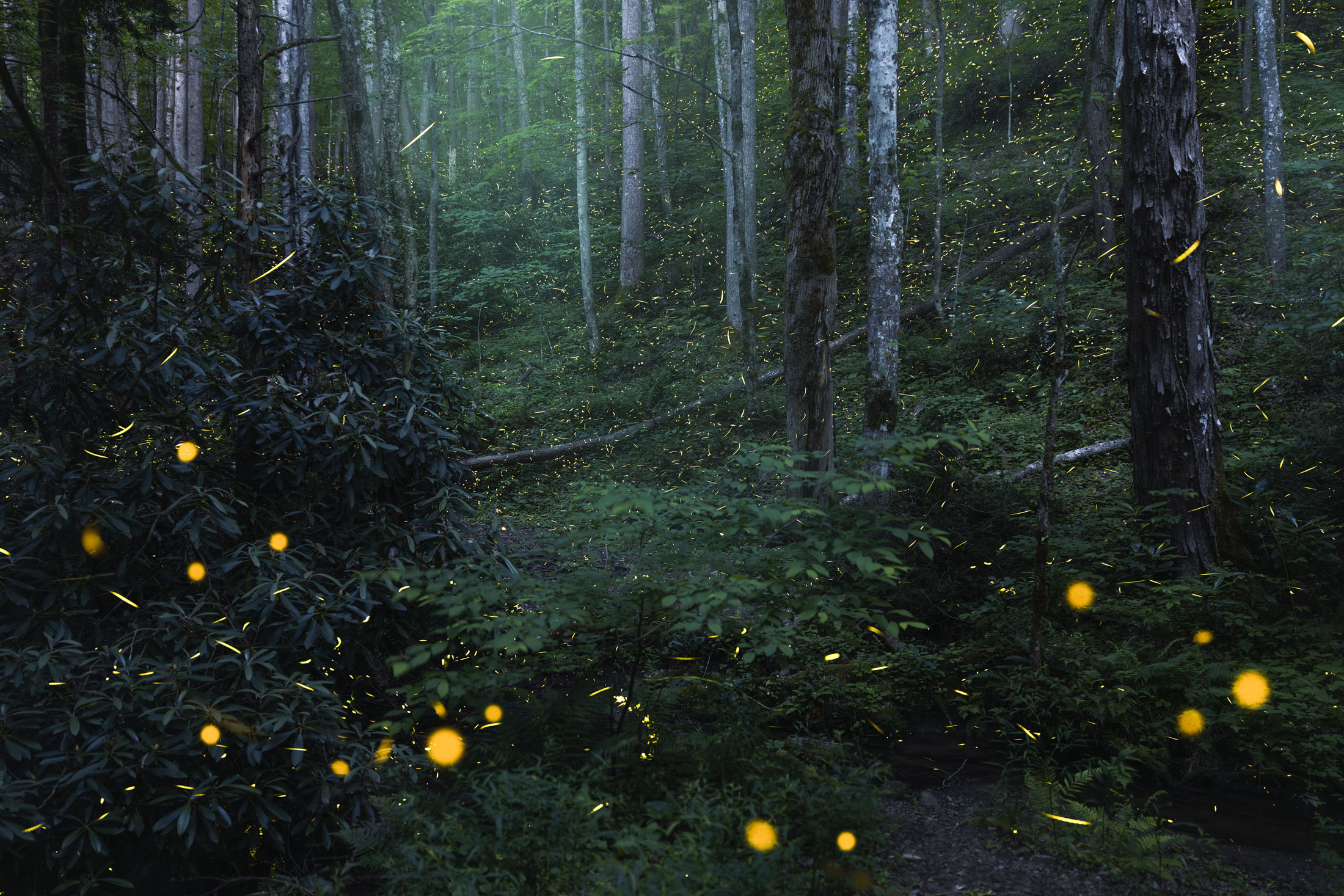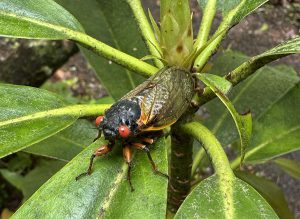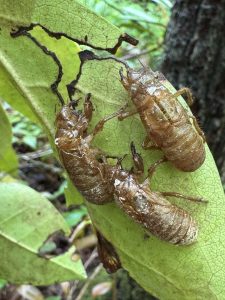
Icing on the cake in our first successful stint as the 2025 Steve Kemp Writer and Illustrator in Residence in the Smokies was being treated to two of nature’s great insectan phenomena this spring: a fabulous emergence of periodical cicadas in May, followed by the amazing light show of the synchronous fireflies of the Smokies in June!

Think of these insects as timekeepers of sorts, with different ways and timescales of counting, and yet counting for essentially the same reason: finding a mate. The firefly’s flashes and cicada’s calls are both male group displays to attract females, and, as with so much in life, timing is everything.
Timing for the famed synchronous fireflies of the Smokies, Photinus carolinus, amounts to counting the seconds right. Their synchrony lies not in lighting up together, but rather in not lighting up together: males on the wing in a given area light up in a frenzy of paparazzi flashbulbs, each individual rapidly flashing around five to eight times, then suddenly all go dark simultaneously. After six to eight seconds of darkness, they again go off like myriad flashbulbs . . . then again abrupt darkness. Females of the species view the spectacle from the ground or low vegetation, subtly signaling back to some lucky male like a wink from across a room. Those out of sync are not likely to draw female attention, while the group display acts as a veritable beacon.
We admired the fireflies amid an aggregation of our own species, two among many dozens of Homo sapiens gathered in Elkmont between the Little River and Bearwallow Branch. We marveled at the twinkling constellations of fireflies rising with the steep bank along the south side of the branch, the amorous beetles unfazed by the occasional moonbeam penetrating the dense tree canopy. After mating, females deposit their eggs on the ground, and the larvae will spend the next one to two years on or in the soil, where they prey upon a host of small invertebrates.

To human eyes, the beetles’ display is an awe-inspiring spectacle—and “spectacle” it is, an overtly visual show for both insects and their human admirers. Not so the periodical cicadas: for them it’s mainly about sound, an aural group display that most people would simply call a din—but one that is surely music to the ears of female cicadas.
Maddening though they may be, you can’t help but marvel at these insects. Adults emerge en masse in staggering numbers only every 17 or 13 years, depending on species, taking that long to slowly grow deep underground, tree root sap their sole source of nourishment. It’s a truly remarkable life cycle embodied in their genus name, Magicicada, derived from the Ancient Greek mágos, “magician.”
They seem magical indeed as they suddenly appear in their teeming millions, alien-looking creatures emerging like an underworld army worthy of Dante or Bosch, ascending trees and shrubs in preparation for their final molt. The newly minted adults soon leave their empty exoskeletal husks clinging to trunks and foliage, as the males rev up their incessant reverberating drone from the treetops.

They make their sound with paired organs called tymbals, located on either side of the abdomen just behind the thorax (the body section bearing their legs). The tymbals are specialized membranes that are rapidly vibrated with musculature, creating audible clicking sounds each time they buckle in and out. As the muscles repeatedly contract and relax with extreme rapidity, the clicks merge into a continuous drone, tremendously amplified by enlarged tracheal air sacs adjacent to the tymbals—basically resonance chambers. (The common green annual or “dog-day” cicadas, which emerge in July or August, make their droning calls in the same way.) Again, timing is everything: chances are, early emergers or stragglers will not find a mate, so there is a strong selection pressure to get the math right and emerge in sync with everyone else.
After mating, females descend from the canopy and seek out young, fresh twigs in which to lay their eggs, inserting them with their sharp ovipositor, or egg-laying structure, and often killing the twigs in the process—tell-tale cicada twig die-off, or “flagging.” Post-mating the adults, too, die off, their life cycle done, the millions of cicada carcasses littering the ground a bonanza for scavengers large and small. Meanwhile the eggs quickly hatch, and the young nymphs drop and burrow into the ground, seeking out the tree’s roots to latch onto with their soda-straw mouthparts, not to be seen again until the year 2042, in the case of this year’s brood.
We heard the calling males at a great distance as we entered Cades Cove on several warm, sunny May days, and here, there, and seemingly everywhere we spotted them too, large black cicadas with ruby-red eyes draped on vegetation and clinging to tree trunks. This year’s periodical cicada emergence belonged to Brood XIV, one of 15 known broods around the eastern US, each of which consists of one or more species on the same emergence schedule. There are three described species of 17-year periodical cicadas and four species of 13-year cicadas. We found at least two 17-year species in different parts of Cades Cove: Magicicada septendecim (the first Magicicada species formally described in 1758), and the slightly smaller M. cassini.

Yes, it certainly was an auspicious start to our Steve Kemp Residency this year, with two remarkable time-keeping insects to admire, two kinds of “synchronicity” to ponder. Consider too how each of these insects plays an important role in Smokies ecology, albeit in rather different ways: the elegant fireflies as predaceous larval marauders of the soil and leaf litter year in and year out, a crucial link in the food chain, while the cacophonous cicadas periodically translocate tons of nutritious biomass to the surface in the form of their very bodies.
Bigger picture, these two or three species belong to a group (the insects) that collectively outnumber all other animals combined in the Smokies. We hope that our forthcoming insect natural history field guide will help park visitors better understand and appreciate these and other marvelous Smokies insects in our midst, the oft-overlooked “little creatures that run the world,” as E. O. Wilson liked to say.
Subscribe to get the latest posts sent to your email.
The Great Smokies Welcome Center is located on U.S. 321 in Townsend, TN, 2 miles from the west entrance to Great Smoky Mountains National Park. Visitors can get information about things to see and do in and around the national park and shop from a wide selection of books, gifts, and other Smokies merchandise. Daily, weekly, and annual parking tags for the national park are also available.